
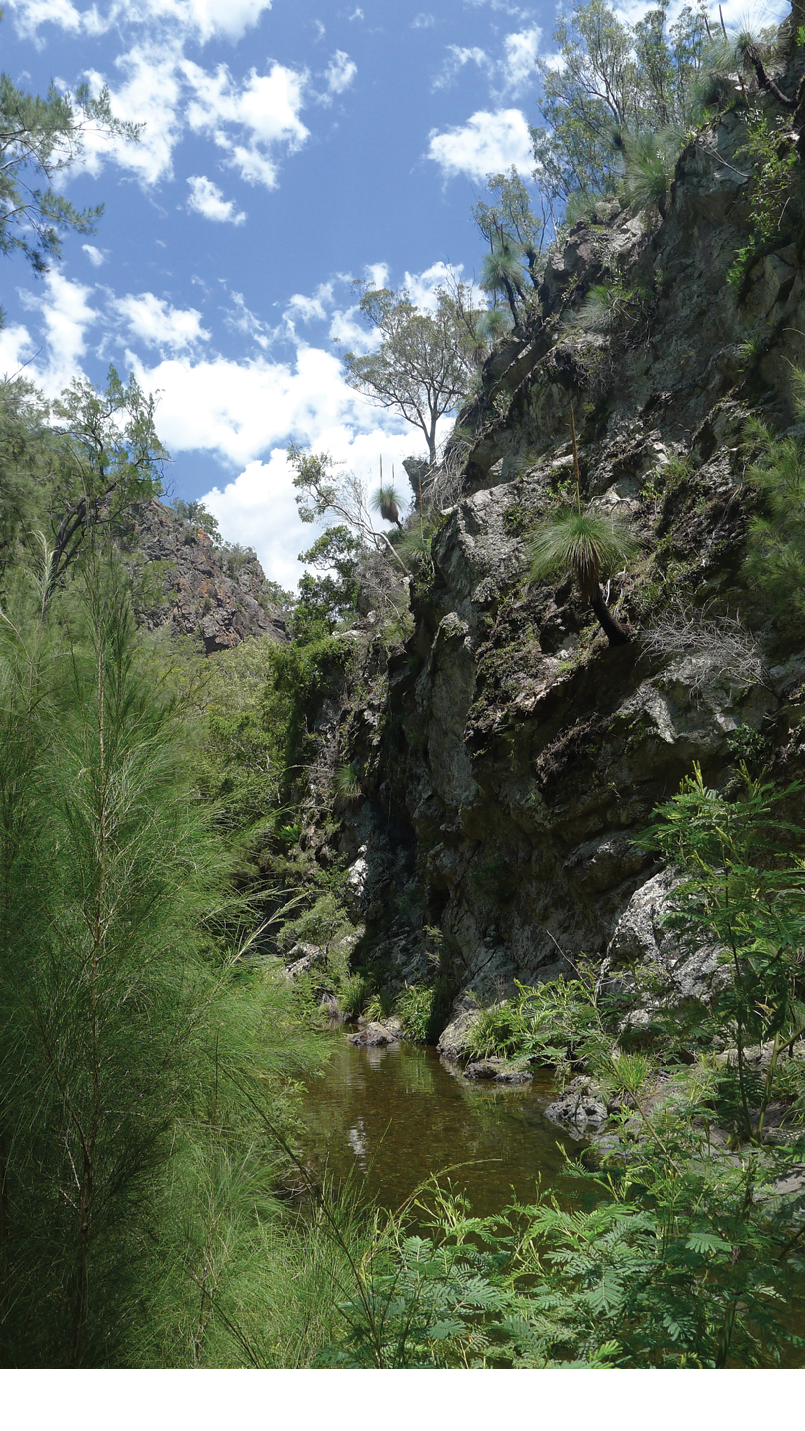

Green Gully Creek gorgeAll pictures by Craig N Pearce
Gnarled fingers of mist dissipated into the closely packed corps of eucalypts guarding the ridges. Low-lying cloud, releasing sheets of drizzle, weighed heavily upon Cedar Creek’s expanse of sloping, open ground and surrounding bush.

Green Gully TrackStockmen and Wallabies, a Very Australian Bushwalk
Craig N Pearce

18 | BWA April 2017
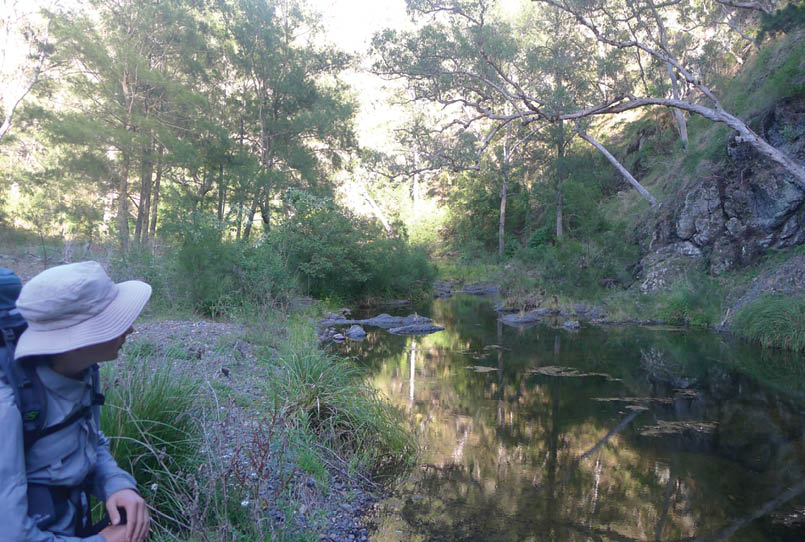
Green Gully Creek
Bodmin Moor is not what I was expecting the week before Christmas at the trackhead of Green Gully Track in NSW’s Northern Tablelands’ Oxley Wild Rivers National Park. And yet, five days later on our return, we were greeted with the same paradox, the same glut of alternately indolent and pugilistically inclined kangaroos, and the same all-pervading tranquillity and sense of isolation.
It’s not uncommon, at this time of the year, for the area to be besieged by searing temperatures. For instance, within two days of my 13-year-old and I starting our trek, despite drinking large amounts of water, Lucifer’s fork had impaled us – me especially – as I was smacked with a dose of sobering, nauseous dehydration.
Climate wasn’t the only dimension of Green Gully Track (GGT) where diversity presented itself. But plenty of trekking experiences have diversity. What very few (none?) have in combination is:
Such a deeply integrated approach to capturing a remote area’s history of cattle grazing and the lives of its stockmen.
For the three nights you are actually en route, accommodation is in refurbished stockmen’s huts, each of them next to original, partly restored, stockyards. The huts feature bunks, water tanks, gas cookers and cooking and eating utensils – oases of convenience which saved considerable pack weight. There are plenty of historical stockmen’s huts in Kosciuszko National Park and in the Victorian high country, but rarely are you actually encouraged to sleep in them, let alone creature comforts or offer exclusive booking rights.
For the first night of arrival at the Cedar Creek trackhead, before trek departure the next day, and the night of arrival back at the trackhead at the walk’s conclusion, the provision of refurbished or new accommodation that has everything the other huts have and a whole lot more, including hot showers and fridges (clearly, a trekkers’ version of luxury …) And get this, you can keep items (hint: beer) in the fridge for your return to trackhead accommodation to welcome you after notching up 65 very strenuous kilometres.
BWA April 2017 | 19

On three specific sections of the track – each about five kilometres – there are no deliberately created tracks. It is up to the navigator to ensure you stay on route. Having said that, all of these sections either have at least a faintly marked track on easy to discern ridges, or run next to (or in) a creek, so it doesn't take a lot of bush nous to stay “un-lost”.
Some 3-5 kilometres, but more if you like, of the track actually being the creek itself – as in, you know, in the creek … This is not a romantic track design flourish; it is dead set necessary to apply “track as creek” due to the surrounding terrain and vegetation. This is slow, slippery going and you can expect to give your delicate areas a rinse or two in the process. Plus, don’t be surprised if there are unplanned for … um … bush baptisms. No matter if it is a cloud-free day, this is a section where a tough garbage bag to line your pack is de rigueur … or suffer the soggy consequences.
“Purchased” solitude. While solitude can occur fairly frequently in the bush, due to the booking system and staged departures of GGT, here it is actually guaranteed that for a minimum of four days you will only see who you want to see (and quite possibly for the starting and ending nights at Cedar Creek, too).
Opened to the trekking public in 2011, the four day GGT experience is now one of Australia’s iconic multi-day walks. Located in the traditional lands of the Thunghutti people and, mainly, within the Macleay Gorges wilderness area, the GGT’s trackhead is situated about 45 minutes north of the Oxley Highway, between Wauchope and Walcha. Creating the trek was, without a doubt, a moment of pure NSW National Parks and Wildlife Service (NPWS) genius.
Oxley Wild Rivers National Park was established in 1986, but subsequently enlarged by further acquisitions such as the territory traversed by the GGT, includes the Apsley-Macleay River system and features the largest protected area of dry rainforest in
Australia. Its terrain is tough, full of gorges and steeply forested hills. Most of the track is within dry sclerophyll forest, with plenty of Silvertop Stringybark, New England Blackbutt, Sydney Blue Gum and White-topped Box, Forest Red Gum and Fuzzy Box. It is replete with many species of flora and fauna, much of which is listed as endangered or vulnerable.
A large part of the park, and the GGT-relevant section in particular, was reclaimed from cattle grazing. The history of this grazing, along with anecdotes and many other points of interest, is explained in information packs found at each night’s accommodation.
Track by rumour, ridge and creekThe heart and soul of the trek are primarily contained within days two and three. That’s when the unmarked track and creek-as-track experiences occur. You get a strong sense of these days towards the end of day one when you arrive at Birds Nest Hut. All of the accommodation is in spellbinding bush settings. But, for me, Birds Nest had that little bit of additional magic, making it all the harder to vacate the following morning.
Birds Nest is more closely cosseted by the bush than its peers; it takes centre stage in a natural amphitheatre. Like all the GGT huts, it’s next to a creek. (I’ve never succeeded in shaking the love of a good creek out of my system. All huts being next to creeks, and also having the uber cool fully-creeked day three experience, made for a happy camper.) Here we were entertained with an intimate performance of birdlife, while the coolness, calm and creek were a mingled sensual susurration. The bush bastard flies – Mongol hordes residing at Green Gully and Colwells Huts – were negligible here, too, making it possible to make a stab at going all meditative beyond the protection of a screen door. Take mesh head nets to ward off the flies – the best $3 you’ll ever spend.
In the morning, it’s hard to pull yourself away from the bucolic freshness of Birds Nest, yet pull yourself away you must, and as early as possible (6.30am in summer
“ ... the four day GGT experience is now one of Australia’s iconic multi-day walks.
“ ... Birds Nest had that little bit of additional magic ...
20 | BWA April 2017
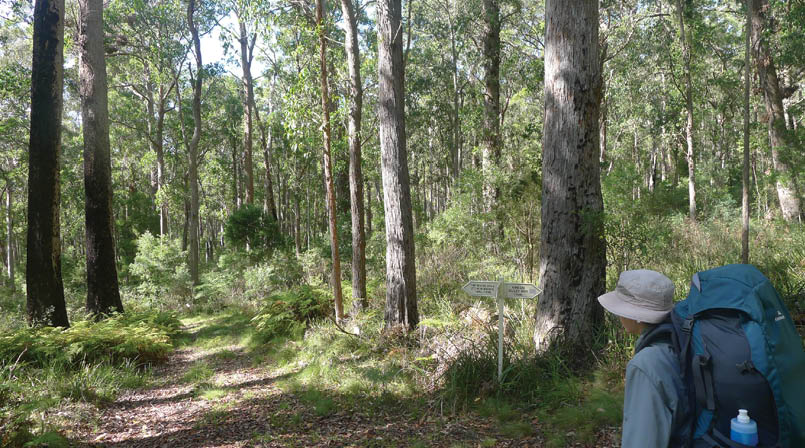
In the thick
being the smart move). This is to avoid the heat on the day’s penultimate section, a slipping and sliding hurtle down the scree of a vertiginous, scantily-treed ridge, where the aforementioned heat and dehydration occurred.
You follow two spurs on day two, one going up, the other down. You initially weave your way through rocks and an invigoratingly scented forest of pines and eucalypts, to the walk’s highest point, where waiting for us was a sleek, long and well fed red-bellied black snake, which eagle eye son spotted before I made the deadly step. From here you pick up a management trail, which due to its dishevelled state is more interesting than those on days one and four, as the bush presses closer, releasing its perfume into your face while the birds carol their seductive siren song, an asymmetric musical puzzle.
Along this section you’ll find the walk’s most spectacular – and certainly the least obstructed – views from lookouts such as Green Gully and The Rocks. They provide momentary respite before the imminent "Iago descent” (i.e. treacherous) to Brumby Pass.
The management trail warms you up for this: steep segments of travel by gravel. Securing reliable purchase is a heart palpitating mix of fun, terror, throw of the dice and strategy. I’ve not been a user of trekking poles previously,
but sharing a pair with my son provided a third point of contact to help with stability and prevent twisted knees or bruising backside landings. The same tool was a boon for the following day’s creek stroll.
Wildwalking by/in/across … waterDay three is pure Green Gully Creek – a bush creek daydreams are made of. You bookend the day with overgrown, barely used management trails running parallel to the creek, peppered by plenty of creek crossings. In the middle you’re either using the creek as a trail or forging a path next to the creek. The latter is pretty low-level bush bashing, as overflowing creek water has quelled the vegetation.
The day is a rock and water double act: spires made of rock, bowls carved out of rock faces, gorges, rock hurdles and rock slippery slides; cascades and pools to lay recumbent by, or in. A briefing from NPWS revealed most of the outcrops are metamorphosed sediments – sedimentary rocks laid down on the sea floor hundreds of millions of years ago, then uplifted and metamorphosed into slightly different compositions during times of volcanic activity, followed by the formation of the Great Dividing Range. The outcrops are formed when harder rocks of higher silica
“Day three is pure Green Gully Creek – a bush creek daydreams are made of.
BWA April 2017 | 21
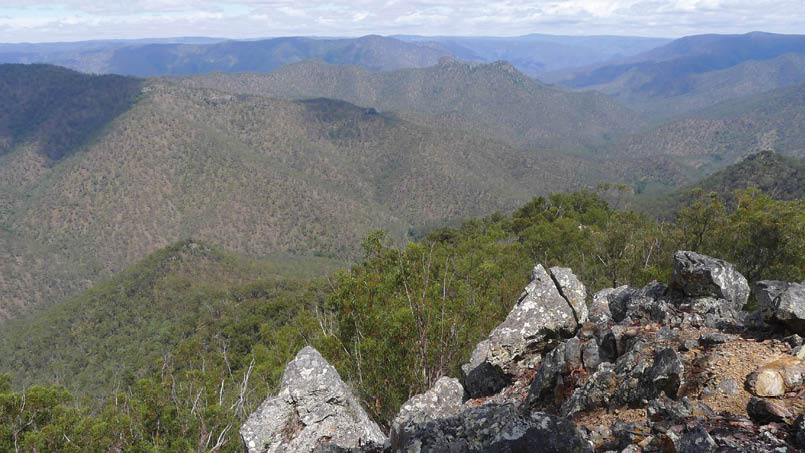
content are left exposed when the softer beds erode away. Different rock colours are due to different chemical compositions.
Steep hillsides are punctuated by Klee-like eucalypts, ectomorphic, searching for succour in the earth and grasping at the sun, laden by inverted lung-clusters of leaves, dun-green umbrellas miserly in their shade offerings.
This is also prime Brush-tailed Rock wallaby sighting day, with plenty of colonies based near the gully. For us, it was also constellations of butterflies day; we were beset by kaleidoscopic milky ways, enhanced by an armada of zipping and levitating fluorescent dragonflies – the original drones.
Throughout the track, birdlife was prolific. Only some of the species I recognised, but among them were Glossy-black Cockatoos, King Parrots and rosellas of a particularly vivid aqua-blue hue I hadn’t encountered before. One animal I didn’t expect to come across deep in a national park was a small herd of cows, looking well fed indeed. NPWS tells me they persist in escaping their farmer’s strictures, this being their third race to freedom in 12 months. The steepness of the ridges makes it difficult to remove them – a truck can’t get to the area and in summer it’s too hot to use horses to force them up
to their adjoining home property. There are limited amounts of wild/feral horses around, evidenced by their hoof prints, but they too are in the process of being removed.
NPWS recommend you bring a pair of trainers for this day so you have a dry pair of boots for day four. I would have been happier wearing boots. They would have protected me more against the sharp rocks I kept slipping against in the creek, and saved me weight and space. Walking in wet boots doesn’t bother me, and if you tend to blister there’s always foot taping.
Ups and downs: return on investment? Or net tangible assets after tracksThere is a downside to the track. All of day one and four of the walk are comprised entirely of very clear, wide, management trails. Additionally, you retrace about 10 kilometres of the same trail, hence doing it twice. To be honest, there is a bit of drudgery and monotony involved here.
However, plenty of beautiful moments do exist on these sections: views over Kunderang Brook Valley and beyond, where waves of hill lines swell up in the foreground, then melt into the pale distance, as well as over pockets of Gondwana relic dry rainforest; creek crossings; the first of the old stockyards, with their innovative bush engineering; and one of the trek’s most
The Rocks Lookout
22 | BWA April 2017
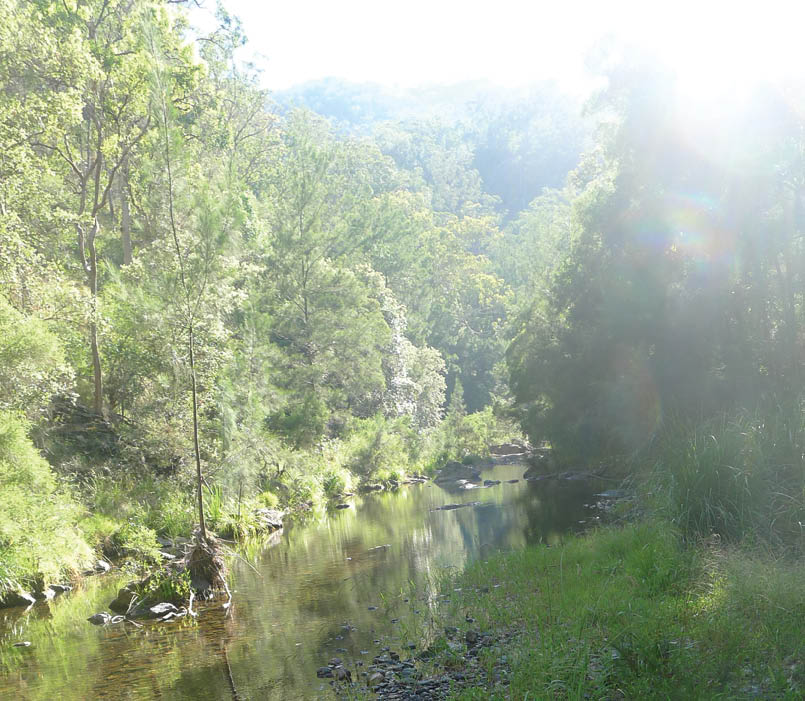
memorable moments – having climbed 600 metres over three hellish, torturous kilometres at the outset of day four, utterly drenched in sweat, the world’s sweetest breeze – free but worth a million bucks – swung through the gullies, ghosted through our very skins and refreshed the engine for at least the beginnings of the next 14 kilometres.
But if the whole four days were management trails like this, all the walking, travel, time and logistics wouldn’t be worth it. The magnificent return on investment provided by all of days two and three, though, and portions of days one and four, not to mention the time at Cedar Creek absolutely make Green Gully Track an experience 100% worth undertaking.
Footnote 1# – Just up the road on the Oxley Highway from the GGT turn off you’ll find Tia Falls and Apsley Falls – don’t miss them. Both are stunning for different reasons, the slate cliffs at Apsley and the seemingly infinite view down the gully from Tia being just two of them.
Footnote 2# – Depending on where you are coming from, try to use Thunderbolts Way to Walcha through Gloucester (and its extension, Bucketts Way, through Stroud). I’ve never been on this road before and the scenery you see is some of the most jaw-dropping you’ll encounter – it’s not a route I can recall seeing in those lists of best drives in Australia, but it should be one of the first pencilled in. Make sure you stop at Carson’s Pioneer Lookout (another top tip from NPWS).
Early morning romanticism, bush-style
BWA April 2017 | 23